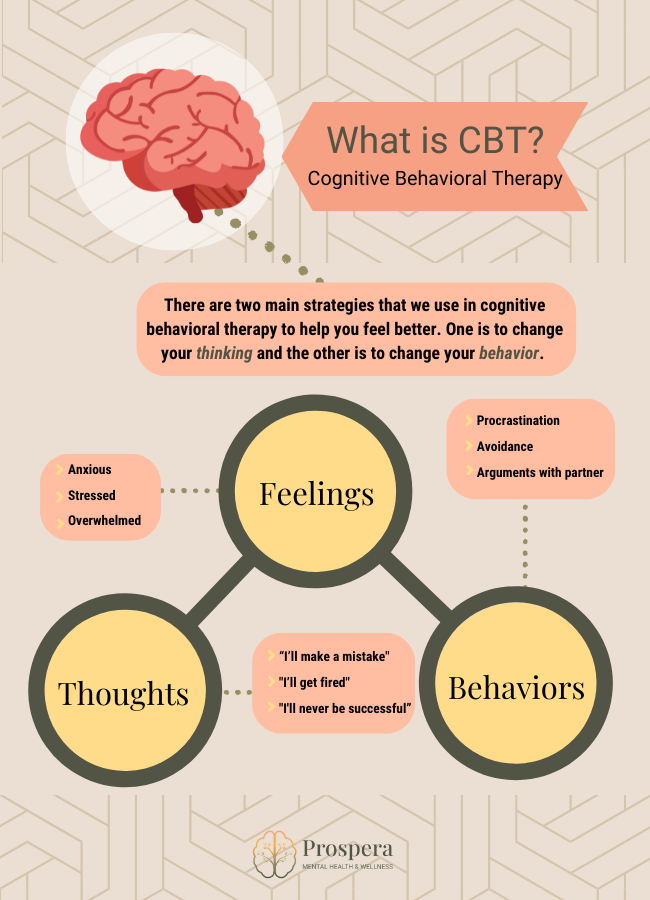What Is Cognitive Behavioral Therapy?

If you’ve read anything about mental wellness in recent years, you’ve probably seen mention of cognitive behavioral therapy, or CBT, but what is cognitive behavioral therapy? Is it just workbooks to track your mood, or a form of positive thinking, or does it go deeper than that? Let’s define CBT, and then we’ll get into how and why it works – and how you can make it work for you!
What is CBT?
CBT includes workbooks and exercises, yes – that’s part of the process – but to be as effective as possible a course of cognitive behavioral therapy should really go beyond those elements. As for positive thinking, that’s a bit of an oversimplification.
The core purpose of cognitive behavioral therapy is to identify thought and behavior patterns that are getting patients stuck in negative places, and then change those patterns to get them unstuck, helping them move toward living the life they want to live.
While there are many physical and digital resources available to help you track your thoughts, feelings, and behaviors (including our extensive tools library), to get the most out of your treatment you’ll want to work with a mental health professional. And, there again, CBT differs from more general ‘talk therapy’ or other therapy techniques, so you’ll want to make sure you work with someone who’s trained in cognitive behavioral therapy.

Why CBT is different from other therapy techniques
One of the main qualities that sets CBT apart from other types of therapy is the clear structure of the process: it’s practiced over a set period of time, at regular intervals, say once a week for 12 weeks. At the outset, you and your provider will discuss your unique needs and set goals together. Periodically, you’ll discuss your progress on those goals. The length of treatment will depend on a number of things including how quickly you progress and whether you have just one primary goal or a few goals to tackle.
That’s another key element of CBT: it’s a collaboration. While there are a number of established CBT techniques that mental health providers will draw upon, those techniques are applied in a unique balance for each patient based on the patient’s needs and the provider’s experience.
And then there’s the homework. You might have heard that term when people talk about CBT, but it’s not something to dread the way it was in school! Cognitive behavioral therapy homework is all about extending the value of your sessions, maximizing the effectiveness of the treatment, and helping you cope with your difficult emotions in real time. Because you only see your therapist for a short time each week, change can be slow – putting in the additional practice outside sessions can help you see results faster.
How does cognitive behavioral therapy work?
The first step in CBT is assessment, working with your provider to figure out where you are in your mental health and where you’d like to go. How are you feeling right now, and how would you like to feel by the end of the course? Then you and your provider will come up with a plan and a timeline together.
Next, you’ll get started identifying thought and behavior patterns, reframing your thoughts, and shifting behaviors to gain more control over your emotions. The first step is carefully tracking your emotions and thoughts, taking time to sit down with yourself and really think about what’s going on inside your head on a daily basis (especially when your anxiety or depression is triggered).
You’ll bring that data to your sessions and your therapist will work with you to drill down into potential triggers, identify patterns, and figure out which exercises (or homework) might be helpful for the next time you experience a surge of negative feelings. From there, you’ll have different types of homework activities like practicing changing your thoughts, engaging in behaviors to lift your mood, or tackling situations you’ve been avoiding due to anxiety. The specific assignments depend on where you are in your treatment.
Why CBT is so effective
CBT has become extremely popular among mental health practitioners for a very good reason: it’s been proven time and again to be the most effective treatment for anxiety and depression.
Over the past few decades, thousands of studies have shown clear improvement in patients suffering from anxiety, depression, PTSD, and a range of other issues in as little as two or three weeks, which is much quicker than most other therapeutic approaches.
Psychotherapy, also known as talk therapy, is especially uncertain when it comes to a timeline – sessions are often relatively unstructured and look less like clear markers of progress and more like conversation about whatever the patient has going on that week.
There are a few key reasons why CBT is so much more effective than talk therapy:
- Scientific Rigor – Unlike talk therapy, CBT is based on a scientific understanding of what causes anxiety or depression. We know that people with these conditions tend to interpret and respond to situations in a specific way that makes it more likely they will feel strong negative emotions. Scientists have been able to observe this by asking questions, observing behavior, and even scanning people’s brains. Basing a treatment on a scientific understanding of what causes a disorder is always the most effective way to reduce symptoms. .
- Focus and Structure – CBT is very focused on the specific problems identified by the patient in the first few sessions and aims to stay focused on those problems consistently. Of course a therapist will adapt to any pressing needs or changing priorities as they arise, but this focus and structure leads to a greater likelihood of achieving the goals set at the outset of therapy.
- Practice and Repetition – The process of doing CBT exercises includes a lot of repetition; patients practice the same exercises many times, applying them to different behaviors, emotions, and situations. This cements the exercises in the patients’ brains – repetition, especially spaced repetition, is one of the best ways to commit information to memory. Even more compelling, repetition creates new connections between prefrontal regulatory brain regions and the brain’s emotion centers, leading to lasting benefits in emotional control over time.

How to improve your daily life with CBT
The great thing about CBT is that, in addition to being super effective for serious mental health issues like depression and anxiety, it can also help with everyday struggles like body image issues, work-related stress, or low self-esteem. Anyone can improve their quality of life by using CBT to control negative emotions and by changing counterproductive thought and behavior patterns.
Online tools and workbooks can help you track and process your emotions, but to get the full effect it’s best to work with a trained therapist or coach. Regular sessions with a trained mental healthcare professional will bolster your efforts with accountability, support, and expertise you wouldn’t otherwise have access to.
Now that you know what CBT is, and why it’s so effective, maybe you’re considering trying it – we’d love to help! Whenever you’re ready, there are two ways to get started:
- Practice spotting thought and behavior traps with our free tools.
- Learn cognitive behavioral therapy skills with one of our professional mental health coaches. Get started here.
Content reviewed by Dr. Andrea Niles, Clinical Psychologist
Anne Godenham is a writer and editor with a passion for mental health awareness and accessibility


